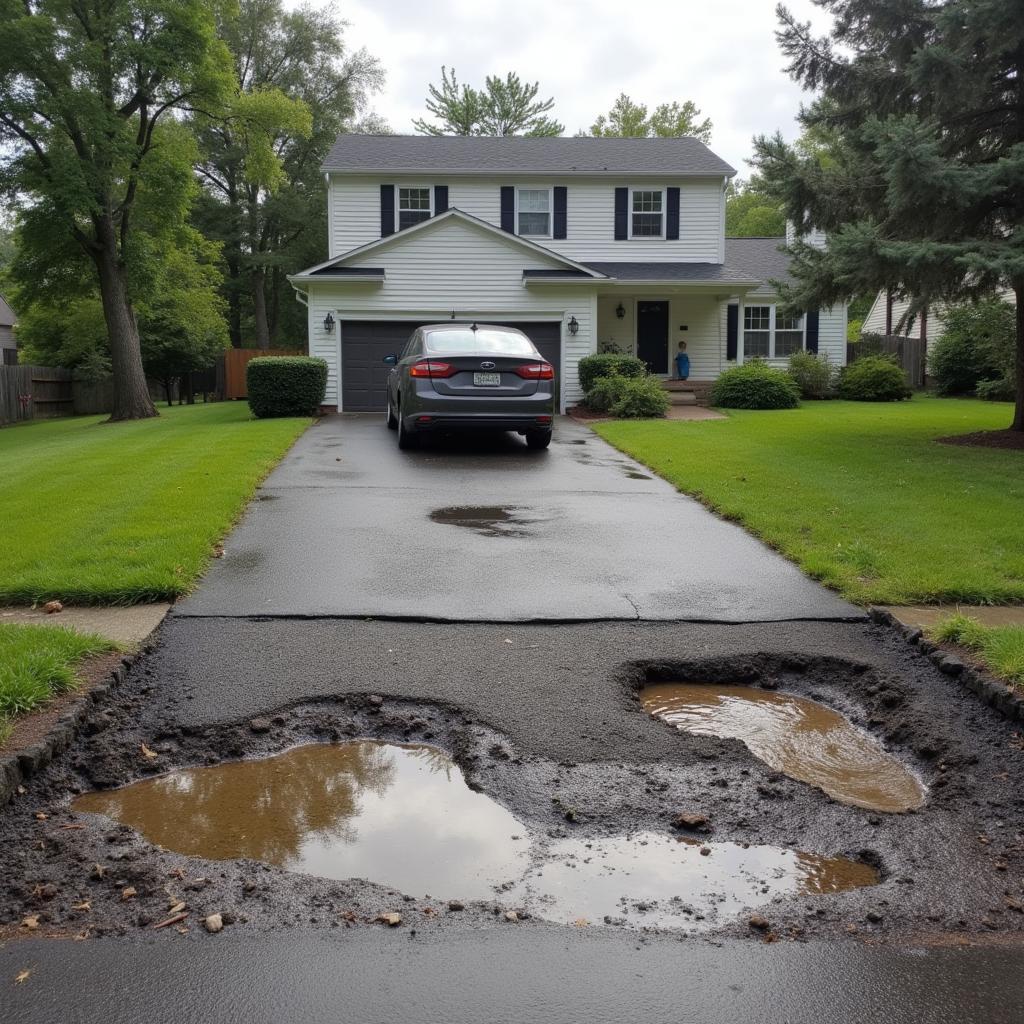Have you noticed a dip or a significant depression in your driveway, right where you usually park your car? This sunken area is a common problem for homeowners, and it’s often caused by the weight of vehicles compacting the soil beneath the pavement over time. While it might seem like a minor annoyance initially, a sunken driveway can lead to drainage issues, tripping hazards, and even affect your home’s curb appeal.
But don’t worry, repairing a sunken driveway, even where your car sits, isn’t always a massive undertaking. Depending on the severity of the problem, you can consider several effective DIY solutions or call in the professionals for more complex situations.
Understanding the Problem: Why Does My Driveway Sink?
Before we dive into the repair methods, it’s important to understand what causes a driveway to sink in the first place. Here are some of the most common culprits:
- Poor Soil Compaction: The most prevalent reason for sunken driveways is inadequate soil compaction during the initial construction. If the soil beneath your driveway wasn’t properly compressed, it can settle over time under the weight of vehicles, leading to a depression.
- Heavy Vehicle Traffic: Parking heavy vehicles like RVs, trucks, or trailers regularly on your driveway can put excessive pressure on the pavement and underlying soil, accelerating the sinking process.
- Drainage Issues: Poor drainage around your driveway can cause water to collect underneath the pavement, gradually eroding the soil and creating voids that lead to sinking.
- Tree Roots: While less common, tree roots growing beneath your driveway can also displace the soil and contribute to sinking, especially if the roots are large or the tree is close to the driveway.
DIY Solutions for Repairing a Sunken Driveway
If the sinking in your driveway is relatively minor, you can try these do-it-yourself methods to fix the problem:
1. Using Gravel or Stone to Fill the Depression
For slight depressions, filling the area with gravel or crushed stone can be a quick and economical solution. Here’s how to do it:
- Clean the Area: Clear away any debris, loose pavement, or vegetation from the sunken area.
- Add the Gravel: Pour gravel or crushed stone into the depression, ensuring it’s slightly higher than the surrounding pavement to allow for settling.
- Compact the Gravel: Use a hand tamper or a plate compactor to compact the gravel firmly, creating an even and stable surface.
**
While this method is simple and cost-effective, it’s essential to remember that it’s a temporary fix, and the gravel may eventually settle, requiring refilling.
2. Patching the Driveway with Concrete Mix
For more significant depressions or if you want a more permanent solution, patching the sunken area with concrete mix is a viable option:
- Prepare the Area: Thoroughly clean the sunken area, removing any loose debris or vegetation. Use a chisel and hammer to create a rough edge around the depression to help the concrete adhere better.
- Mix the Concrete: Follow the manufacturer’s instructions to mix the concrete. For smaller repairs, pre-mixed concrete in bags is a convenient choice.
- Pour and Level the Concrete: Pour the concrete mix into the depression, ensuring it’s slightly higher than the surrounding pavement to allow for settling. Use a trowel to spread the concrete evenly and create a smooth surface.
- Cure the Concrete: Cover the patched area with plastic sheeting to prevent it from drying too quickly, which can weaken the concrete. Allow the concrete to cure for at least 24 hours, or as recommended by the manufacturer, before driving on it.
**
When to Call a Professional
While the DIY methods mentioned above can effectively address minor sinking, more severe cases often require the expertise of a professional driveway repair contractor. Consider calling a pro if:
- The sunken area is extensive.
- The pavement is severely cracked or damaged.
- There are signs of significant drainage problems.
- You suspect underlying soil erosion or instability.
Preventing Future Driveway Sinking
Preventing future sinking is just as crucial as repairing existing damage. Here are some proactive steps to safeguard your driveway:
- Ensure Proper Drainage: Ensure adequate drainage around your driveway to prevent water from pooling and eroding the soil beneath the pavement. Install gutters, downspouts, or French drains to redirect water flow away from your driveway.
- Avoid Parking Heavy Vehicles: Limit parking heavy vehicles like RVs, trailers, or boats on your driveway for extended periods. If you have to park them occasionally, try to distribute the weight by using plywood sheets under the tires.
- Inspect Your Driveway Regularly: Regularly inspect your driveway for signs of cracking, sinking, or drainage issues. Addressing these problems promptly can prevent further damage and costly repairs in the long run.
By understanding the causes of sunken driveways and taking proactive measures, you can keep your driveway looking its best and extend its lifespan significantly.



